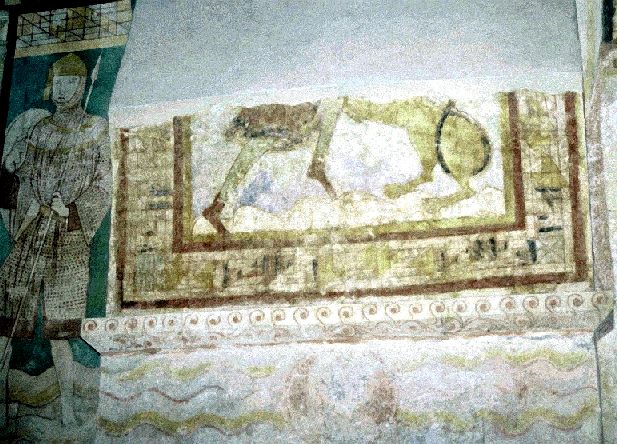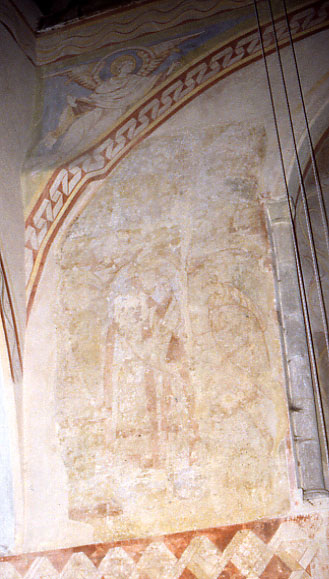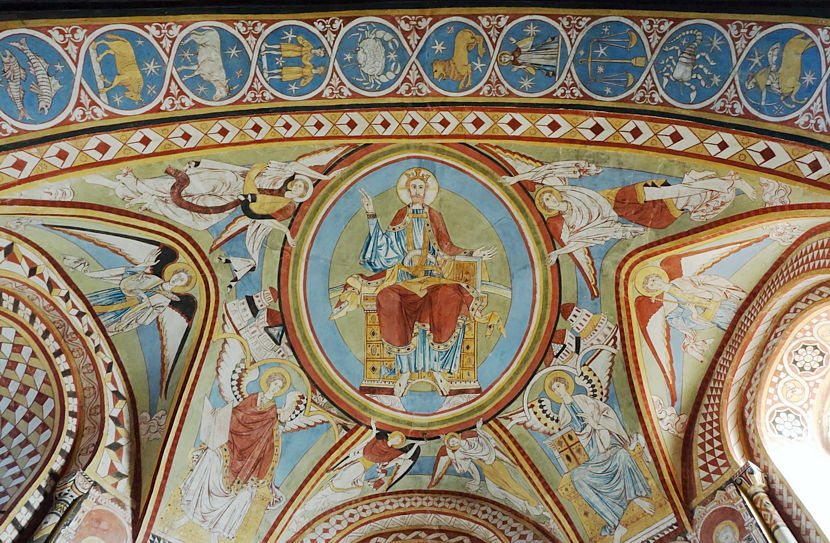Copford Green, Essex (†Chelmsford) c.1130
David Overcoming the Lion?

Less than half of the main subject of the painting is left, but, like The Raising of Jairus’s daughter nearby in the nave, and unlike the heavily repainted subjects in the apse, it is substantially as the original painter left it. Identification of the subject must remain tentative, but EW Tristram¹ suggested David and Lion, as in the reported incident in 1 Samuel 17: 33-35, although there are other contenders, such as Samson.
The painting seems to have been part of an allegorical series representing various Triumphs of Virtues over Vices, and the repainted knight standing at the left above is probably intended as a symbolic representation of a specific virtue. Tristram has illustrations of one other and part of a third, the complete figure, in very similar armour to the one shown above, standing on some kind of animal representing the Vice overcome. These have deteriorated considerably since Tristram’s day, but the faded remains of one of them, untouched by the Victorians, is shown below at the right.

The contrast between this shadowy figure and the modern geometrical regularity of the decorative painting around it is instructive, and this is even more marked in the two final photographs here. The first, at the left, shows an unidentified medieval subject, possibly the Christ and the Woman of Samaria mentioned by Tristram, accompanied by what is probably the profile figure of another faint Virtue to the right of it and a distinctly 19th century flying angel above in the spandrel.

Finally, the painted apse and its arch are shown in the photograph below. More flying angels are partly visible in the spandrels of the arch, and on the soffit are the signs of the Zodiac on a blue ground. Beyond, above the High Altar and the window is Christ in Majesty, painted in a roundel and surrounded by angels. A row of Apostles stands below.
The whole scheme is essentially Victorian; a very old photograph of the apse taken before the repainting in 1872 and reproduced by Tristram² confirms the general layout of the subjects, including the roundel and the Zodiac, but virtually all details were fragmentary, very blurred, and indistinct even then. As a result, much of the repainting must have been based on conjecture – the Copford apse is a Victorian idea of what a medieval painted scheme ought to look like.
As to the scheme in the nave, possibly all the paintings there, including The Raising of Jairus’s daughter linked above, formed part of a psychomachia similar in intention, if not in detail, to that at Claverley in Shropshire, also from the 12th century.

Website for St Michael & All Angels, Copford
¹ Tristram 1, p. 118
² Ibid, Plate 74